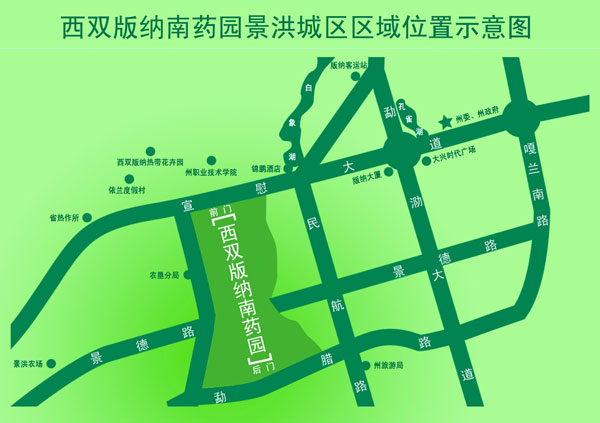

西双版纳南药园是中国医学科学院药用植物研究所云南分所的一项科普旅游开发项目,地处云南省西双版纳州首府景洪市中心。园区占地约20公顷(湖面约3公顷),主要从事热带药用植物种质资源保存、引种栽培、旅游开发、科普教育等活动。
目前园内引种收集南药、民族药及其他药用植物1200多种,其中包括阳春砂仁、胖大海、白豆蔻、檀香、龙血树、儿茶、肉桂、金鸡纳等三十多种名贵南药。保存有药用植物标本10000余份,并拥有全国最大的胖大海、马钱、催吐萝芙木种质资源库、300多种原生兰科植物以及国内人工种植年限最长的土沉香、印度紫檀等重要南药。
西双版纳南药园于2000年被云南省政府授予“云南省科普及教育基地”称号,2006年被国家基经委授予“国家理科基础科学研究与教学人才培养基地——云南大学生物学专业实习基地”称号,2007年7月经全国旅游景区质量等级评定委员会批准成为“国家AA级旅游景区”。 同时,西双版纳南药园也是云南热带作物学院、西双版纳职业技术学院等大专院校的教学实习基地。
西双版纳南药园以传统医药文化为主线,结合现代生态学、园林景观学、植物分类学、旅游学等专业知识及对现代旅游内容与环境的整体要求,精心规划布置。当您走进园区,首先来到的是药文化广场,栩栩如生的傣医药文化雕塑,向你展示了民族医药的神奇历史;沿着“药文化”的主线,依次走进南药秘园、荫园、百草园、兰园、傣药园、槟榔园、秀园、胖大海种质园、景园、南药科技馆等十个特色区域。让您领略丰富多彩的热带、亚热带药用植物资源,体会灿烂的中国医药文化,从而把博大精深的中药文化和具有浓郁民族特点的傣医药文化与药用植物有机融合。
Botanical Garden of Xishuangbanna South Medicine
Botanical Garden of Xishuangbanna South Medicine, founded in 1959, is located in Jinghong city of the capital of Xishuangbanna prefecture, Yunnan province and it is also a branch of Institute of medicinal Plant Development, Chinese Academy of Medical Science in Beijing China. The garden covers an area 20 hectares including 3 hectares artificial lake. The mainly objectives of the garden include germplasm conservation of tropical botany, introduction and cultivation, scientific research, public science education and sightseeing for tourist.
To date, the garden has a collection of about 1000 tropical plant species and varieties from different parts both from home and abroad. Among these include Amomum villosum, Sterculia lychnophora, Amomum kravanh, Santalum album, Dracaena cambodiana, Senegalia catechu, Cinnamomum cassia, Cinchona succirubra, and so on, over thirty noble medicinal plants in southern China. In addition, the plant herbarium room of the garden has a collection of over 10000 accessions. In 2000 years, the garden was awarded a title ‘Base of Public Science Education and Popularization’ by the government of Yunnan province.
Botanical Garden of Xishuangbanna South Medicine has been planed and constructed following a mainly clue that is traditional Chinese medicine and folk culture. Simultaneously, modern ecology, landscape architecture, landscape science, systematic botany, tourism, etc are also considered in the garden program.While entering the garden, t
he first site is the plaza of medicine culture where has a lifelike sculpture showing the development history of Dai medicine culture, and then are ten regions with several characteristics including the mysterious trail of medicinal plant, shady pathway, Dai medicine, orchid room, herb area, areca woods, germplasm garden of Scaphium lychnophornm, and Xiuyuan. These abundance plant resources and good garden distribution display the medicine fortune of the nationality of Dai in Xishuangbanna. The science and technology house of tropical medicinal plants is located in the south-west of the garden where you can further learn the splendent history of the folk medicine culture.